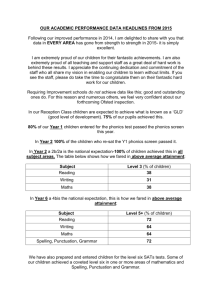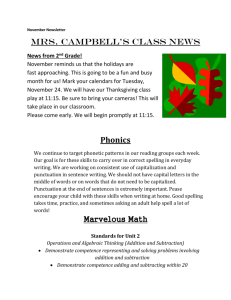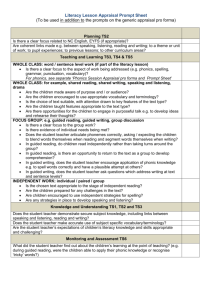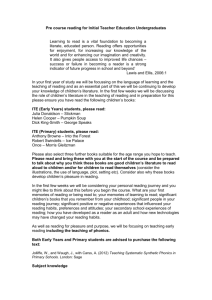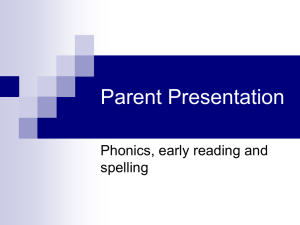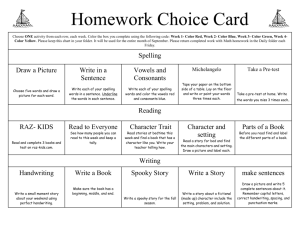English
advertisement
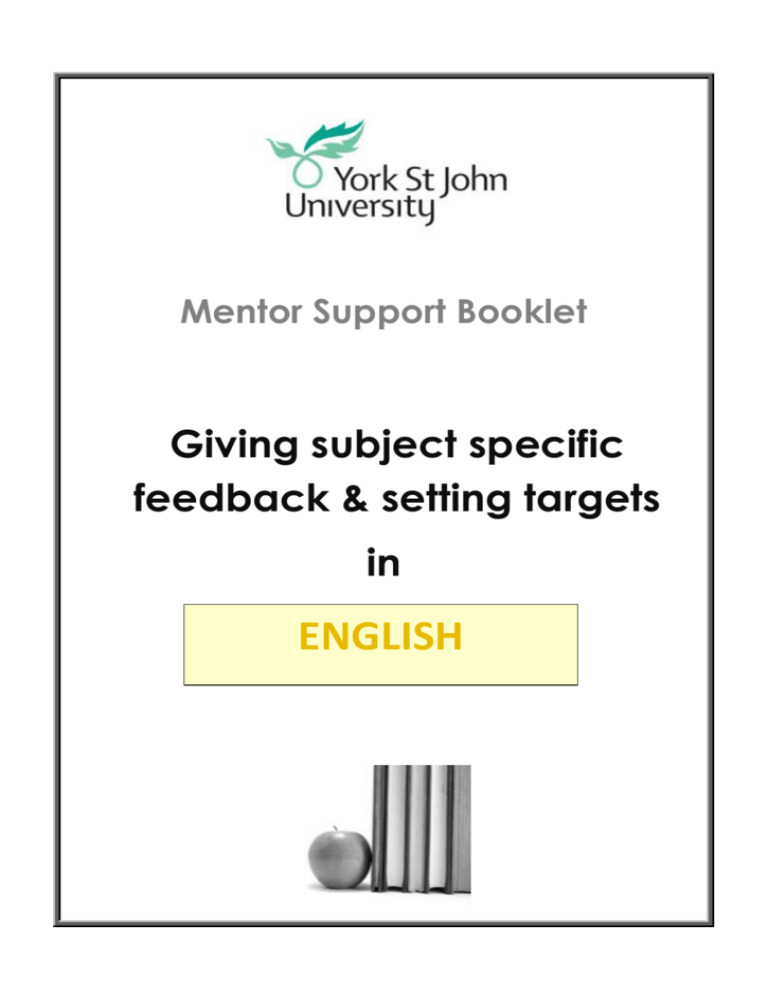
Mentor Support Booklet Giving subject specific feedback & setting targets in ENGLISH CONTENTS Section English Subject Knowledge Page 3 Speaking and Listening: -Key messages for student teachers 4 -Examples of targets for student teachers Phonics: -Key messages for student teachers 6 -Examples of targets for student teachers Reading: -Key messages for student teachers 8 -Examples of targets for student teachers Compositional aspects of writing: -Key messages for student teachers 10 -Examples of targets for student teachers Transcriptional aspects of writing; -Key Messages for Student Teachers - Examples of targets for student teachers 12 English Subject Knowledge Good teaching is grounded in secure subject knowledge – both knowledge of the subject (for example, what a complex sentence is) and pedagogic subject knowledge (what to teach children about sentences, and how). Student teachers will benefit from feedback which focuses specifically on their subject knowledge, and guidance when necessary on how to develop it. This booklet outlines key messages for English teaching. These of course go alongside messages about good practice in general which will improve not only English teaching but all teaching for example, engaging children in their learning by starting the session in an imaginative way, or the importance of ensuring teaching meets the needs of all learners, or the need to become familiar with school policies on, for example, marking. The key messages for English are based on evidence of what works from recent research, reports and national guidance. They can be used as the basis for targets, often with little or no modification, but in addition examples are given of targets. To develop their subject knowledge, student teachers can be referred to their own notes from teaching sessions, and the very wide range of materials available to them on the Primary English and phonics areas of the university’s virtual learning environment. These materials are helpful where student teachers need to work on aspects which have not yet been covered in the taught programme (writing for both first year student teachers on the undergraduate programme and student teachers on SE2 on the postgraduate programme). Speaking and Listening Key messages for student teachers: Children learn through talking, but two-thirds of classroom talk is teacher talk. Find ways of talking less and allowing children to talk more. Develop genuine discussion, rather than a series of teacher questions, brief child responses and teacher feedback, by taking time to listen carefully to what children say. Use more open-ended questions, and prompts such as ‘I wonder…’. Avoid unfocused praise such as ‘fantastic, brilliant’; instead prompt further thinking and talking (e.g. ‘Say a bit more about that…’) Develop an exchange with one pupil at a time rather than trying to involve everyone. Allow thinking time so children can make considered contributions to talk; use talk partners to involve all children. Plan carefully for talk, considering possible directions discussion might take and preparing relevant prompts, but be ready to follow the children’s interests and ideas if appropriate. Vocabulary is hugely important in language comprehension, and children’s vocabularies differ in size very significantly early on, depending on their early language experience. Develop vocabulary in a considered way, planning which words to introduce (how useful will they be to the child in the future?) and ensuring they are repeated often enough, in different contexts, to be absorbed into the child’s own vocabulary. Use challenging words in your own speech. Have a school dictionary to hand when discussing words with children, to ensure they can be given a helpful definition. Model Standard English when you are with the children. Avoid regional dialect forms such as we was, I were, have wrote. Examples of targets for student teachers When children are working independently, watch and listen before intervening. Ensure your explanations and instructions are concise and clear. In whole-class teaching, encourage children to speak so that others can hear them, rather than repeating what they say. Ensure your explanations and instructions are concise and clear. Plan your questions carefully, to give children opportunities to explain, compare, summarise, analyse, evaluate. When you reflect on learning consider whether your questions did lead to extended and thoughtful contributions. Keep your introductions brief: show rather than telling. Ensure you model Standard English at all times. Phonics Key messages for student teachers: Phonic skills and knowledge underpin both reading and writing. Children need a secure understanding and knowledge of the alphabetic code in order to read and write accurately and fluently, leaving them free to attend to meaning. Teacher subject knowledge is crucial; teachers need to be absolutely secure in their understanding of the alphabetic code (for example, that ‘tch’ represents the /ch/ phoneme in match, or that ‘ou’ can represent different phonemes (in about and you, for example). Weak subject knowledge leads to ineffective or even misleading teaching. Systematic phonics teaching begins in the reception year; before this children need a rich experience of language play and rhymes, including games involving oral blending and segmenting, and a developing awareness of print and interest in mark-making. Phonics is best taught in short daily sessions, usually following the four-part structure Re-visit, teach, practise, apply. The teach section should introduce new knowledge to the children. In the practise session children should be working independently, alone or in pairs. In the apply section children should together be reading or writing a whole sentence or short text using their new knowledge. Each session should give every child many opportunities to blend and / or segment words. Phonemes should be articulated clearly and without an additional ‘uh’ sound with phonemes such as /b/, /t/, /l/. Letter names should be used when referring to the letter rather than the phoneme it generally represents (e.g. the ‘ed’ word ending should be described as the ee dee ending rather than the /e/ /d/ ending). Shared and guided reading and writing should provide opportunities as appropriate for children to apply their phonics skills and knowledge in order to read and write independently. Prompts should encourage that independence: e.g. What could you do to help you read that word? How could you break that word up to help you read it? Expect children to sound out and blend as their prime strategy for tackling unknown words. Give additional support with irregular words. Check that texts to be read independently are at the right level for the child or group; if necessary modify the text rather than having the child dependent on adults to read it to them (this applies to reading across the curriculum). Expect children who are secure at Phase 3 in phonics to have a go at writing any word. Examples of targets for student teachers Ensure when you segment words that each phoneme is distinct (e.g. /s/ /t/ /o/ /p/). Use prior assessment of children’s phonic knowledge to check that you do not teach a grapheme-phoneme correspondence they already know. In whole-class teaching, encourage children to speak so that others can hear them, rather than repeating what they say. Please also refer to the Phonics Appraisal Pro-forma / Prompt Sheet (SE Appraisal Documentation) Reading Key messages for student teachers: Good teachers of reading are readers themselves. They need an extensive knowledge of children’s literature, and an interest in and appreciation of the texts they teach. They need to take time to familiarise themselves with texts and explore them in some depth before sharing them with children, in order to know what the text may have to offer. Planning needs to ensure a match between the text selected and the aspect(s) to be studied; these could include: For fiction - genre, setting, character, plot, narrative viewpoint and structure, theme, mood, language For poetry - theme, language and imagery, rhythm and sound patterns, form and structure For non-fiction - features of the specific text type (recount, instructions, nonchronological report, explanation, persuasive writing, discussion). Shared reading is a key methodology in reading teaching. In the early stages children read the text aloud together, with teacher support as needed. For older readers the text may be read silently, but in lessons with a reading focus children should always be reading for themselves rather than having the teacher or another child read to them. Guided reading is another key approach in reading. Children should be reading to themselves, at their own pace, rather than reading round the group, to maximise the opportunity for practice and problem-solving. The guided reading session appraisal proforma gives useful prompts. Comprehension: lessons with a reading focus may give useful opportunities for children to apply their phonics skills and knowledge to texts, but the main focus will be on comprehension and response. Comprehension needs to be taught through, for example, modelling and explanation, rather than simply tested through questioning. DARTs (Directed Activities Related to Texts) can be effective activities, but need to be carefully matched to the text and should include time to reflect on learning (How did you work that out? Were there other clues? Which bit of the text made you think that?). Carefully thought through drama can deepen children’s understanding. Becoming a reader: many children learn to read but do not develop positive attitudes to reading or a positive view of themselves as readers. It is important to present reading as a pleasurable experience – through, for example, reading high quality fiction to children, sharing poems at odd moments, discussing books informally, presenting books in the classroom in an attractive and imaginative way, and recognising and valuing the many forms of reading that children do. Examples of targets for student teachers Ensure that all children join in during shared reading. In guided reading, plan carefully to include a balance of literal, inference and evaluative questions. Prompt children to go back to the text to support their answers. Please also refer to the Guided Reading Session Appraisal Proforma / Prompt Sheet (SE Appraisal Documentation) (SE Appraisal Documentation) Compositional Aspects of Writing Key messages for student teachers Writers need to understand the purpose of their writing and to have a sense of their audience. Writers need to know how to plan and structure their writing. They need to be familiar with a range of text types and be confident when writing in those forms. Talk can provide a valuable opportunity to gather ideas, plan and rehearse writing. Drama often provides a good way in to writing, but the activity must be carefully matched to the text type. Writing can often be a collaborative activity, and even when writing is individual response partners provide valuable support at the re-drafting stage. Children should see themselves as writers but know that writing can be a difficult process for all writers at times. Writing is both an art and a craft. Many techniques can be taught but factors such as imagination, a flair for language or a sense of humour are harder to develop. Very good writers are often voracious readers. Children need to feel that content – what they write and how they say it – is more important than spelling, punctuation and handwriting. Comments and targets should reflect that balance. Writing reads better when sentences are varied in a range of ways: in length, in type (simple, compound and complex; statements and questions) and in how they open. Children need to experiment with ways of extending and reordering their sentences and combining short sentences. Vocabulary choice is crucial in writing. Children need to consider the words they use for particular purposes and in particular contexts, and evaluate their impact. New words should be introduced to them regularly. Shared writing, including teacher demonstration, teacher scribing and supported composition, should be used regularly as a strategy for teaching writing. Guided writing provides an opportunity for focused, differentiated support at any stage of the writing process. Examples of targets for student teachers When modelling writing, share the decisions you are making as a writer with the children. In guided writing, encourage children to re-draft sentences, modelling if appropriate. When giving feedback on writing pick out specific examples of, for example, good vocabulary choices, but remember also to comment on overall features such as structure or awareness of the audience. Use the plenary to focus on one piece of writing (shared using the visualiser) for self-evaluation and redrafting. . Transcriptional Aspects of Writing Key messages for student teachers: In the early stages spelling depends on phonic skills and knowledge, but to make correct spelling choices children need to adopt a visual strategy (Does it look right? ) Children need to learn not only spelling patterns and rules but also strategies for spelling words they do not know and for learning spellings. Spelling should be taught in regular short sessions, focusing on a spelling pattern or strategy, or through investigations. An over-emphasis on correct spelling (for example, in marking) may result in children writing less and using less adventurous vocabulary. Children use a wider range of punctuation and use it more accurately if they are encouraged to investigate and experiment rather than teaching having a narrow focus on correct punctuation. Sentence punctuation cannot be taught meaningfully until children are writing several sentences and have developed a sense of what a sentence is. In handwriting, legibility and speed are crucial, rather than neatness. As soon as pencil control has been established a joined script should be used. Prioritise the teaching of handwriting in the reception year, especially the establishment of a good pencil grip and correct letter formation. Examples of targets for student teachers Use children’s spelling errors diagnostically to plan your spelling teaching. Note in your assessments what strategies children are using to spell words. vocabulary choices, but remember also to as Observe the children comment overall they writeon and tackle any features such as issues of pencil grip and structure or letter formation awareness (reception,oforthe if necessary audience. in other age groups). vocabulary choices, but remember also to comment on overall features such as structure or awareness of the audience. Ensure your own understanding of the punctuation of direct speech is clear and plan carefully how you will explain it in your next lesson. Plan a series of activities to help the children in learning to recognise where sentence breaks occur in prose. . Model the school’s handwriting style consistently (on the board, in children’s books).

